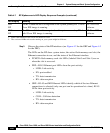
4-3
Cisco 12010, Cisco 12410, and Cisco 12810 Router Installation and Configuration Guide
OL-11496-01
Chapter 4 System Startup and Basic System Configuration
Boot Process Overview
• A terminal device is connected to the console port on the RP, powered on, and
configured for 9600 bps, 8 data bits, no parity, and 2 stop bits (9600, 8N2).
Note You must connect a terminal to the RP to perform the initial configuration
of the router.
• The flash memory card that shipped with your router is installed in slot 0 of
the RP. The software configuration register is set to 0x0102 (default), causing
the system to boot automatically from the Cisco IOS software image stored
on the flash memory card.
After you complete the above, proceed to the following section to start the router.
Boot Process Overview
The following sequence summarizes a typical boot process.
1. You power on the router.
2. The RP MBus module receives +5 VDC voltage and starts executing MBus
software.
3. The RP determines the router configuration by sending a message over the
MBus requesting all installed devices to identify themselves. Their responses
provide the RP with slot numbers, card, and component types.
4. The RP, line cards, switch fabric cards (CSCs and SFCs), and alarm card are
then powered on.
5. The power-on-reset logic of the RP is delayed to allow power for both local
and CSC clocks to stabilize.
6. After the power-on reset logic is released, the RP begins to execute the ROM
monitor software.
–
If the ROM monitor is configured to autoboot, the system automatically
loads and boots the Cisco IOS software.
–
If the ROM monitor is not configured to autoboot, you must boot the
Cisco IOS software manually.


















